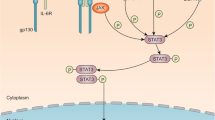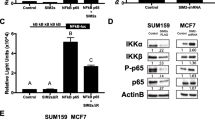Abstract
Breast cancer is the most frequent neoplasia in women and is responsible for approximately 13.8% of deaths per year for this gender. It has been suggested that JAK2, STAT3, and NF-κB gene expression is involved in this type of cancer. The objective of the present study was to determine the effect of bistriazole in these signaling pathways in patients with breast cancer and benign mammary lesions. The inhibitory concentration 50 of bistriazole was calculated in cell cultures of patients with benign lesions, Probit = 4.6 μM with IC = 95%. The study was performed by examining 63 women who submitted to mammary biopsies. Biopsies of the mammary lesions were performed, gene expression was determined, and cells were cultured in the presence of 4.6 μM bistriazole. We found that breast cancer is related to age greater than 50 (P ≤ 0.01), being overweight (P ≤ 0.023) and having a waist circumference larger than 80 cm (P ≤ 0.01). The gene expression of JAK2, STAT3, and NF-κB was higher in groups of patients with breast cancer, while SOCS3 expression was lower. After being exposed to bistriazole, the expression of JAK2 and STAT3 decreased, and the expression of SOCS3 and NF-κB increased. In conclusion, this molecule in development has an effect on the gene expression of JAK3 and STAT3; nevertheless, the lack of change in NF-κB indicates that it is not a regulator of inflammation, and therefore, more studies should be performed.
Similar content being viewed by others
References
Aizpurua JM, Azcune I, Fratila RM, Balentova E, Sagartzazu-Aizpurua M, Miranda JI (2010) Click synthesis of nonsymmetrical bis (1,2,3-triazoles). Organic Lett. 12(7):1584–1587
Babon JJ, Kershaw NJ, Murphy JM, Varghese LN, Laktyushin A, Young SN et al (2012) Suppression of cytokine signaling by SOCS3: characterization of the mode of inhibition and the basis of its specificity. Immunity 36(2):239–250
Chávarri-Guerra Y, Villarreal-Garza C, Liedke PER, Knaul F, Mohar A, Finkelstein DM et al (2012) Breast cancer in Mexico: a growing challenge to health and the health system. Lancet Oncol 13(8):e335–e343
Duan Y-C, Ma Y-C, Zhang E, Shi X-J, Wang M-M, Ye X-W et al (2013) Design and synthesis of novel 1,2,3-triazole-dithiocarbamate hybrids as potential anticancer agents. Eur J Med Chem 62:11–19
Furth PA (2014) STAT signaling in different breast cancer sub-types. Mol Cell Endocrinol 382(1):612–615
German CL, Sauer BM, Howe CL (2011) The STAT3 beacon: IL-6 recurrently activates STAT 3 from endosomal structures. Exp Cell Res 317(14):1955–1969
González J, Pérez VM, Jiménez DO, López GL, Corona D, Cuevas EY (2011) Effect of temperature on triazole and bistriazole formation through copper-catalyzed alkyne–azide cycloaddition. Tetrahedron Lett 52:3514–3517
Guo S, Liu M, Wang G, Torroella-Kouri M, Gonzalez-Perez RR (2012) Oncogenic role and therapeutic target of leptin signaling in breast cancer and cancer stem cells. Biochim et Biophys Acta (BBA). 1825(2):207–222
Gupta N, Grebhardt S, Mayer D (2012) Janus kinase 2—a novel negative regulator of estrogen receptor α function. Cell Signal 24(1):151–161
Harbeck N, Salem M, Nitz U, Gluz O, Liedtke C (2010) Personalized treatment of early-stage breast cancer: present concepts and future directions. Cancer Treat Rev 36(8):584–594
Haricharan S, Li Y (2014) STAT signaling in mammary gland differentiation, cell survival and tumorigenesis. Mol Cell Endocrinol 382(1):560–569
Hou Y-P, Sun J, Pang Z-H, Lv P-C, Li D-D, Yan L et al (2011) Synthesis and antitumor activity of 1,2,4-triazoles having 1,4-benzodioxan fragment as a novel class of potent methionine aminopeptidase type II inhibitors. Bioorg Med Chem 19(20):5948–5954
Jardé T, Perrier S, Vasson M-P, Caldefie-Chézet F (2011) Molecular mechanisms of leptin and adiponectin in breast cancer. Eur J Cancer 47(1):33–43
Khandekar MJ, Cohen P, Spiegelman BM (2011) Molecular mechanisms of cancer development in obesity. Cancer 11:885–895
Kumar K, Sagar S, Esau L, Kaur M, Kumar V (2012) Synthesis of novel 1H-1,2,3-triazole tethered C-5 substituted uracil–isatin conjugates and their cytotoxic evaluation. Eur J Med Chem 58:153–159
Li F, Sethi G (2010) Targeting transcription factor NF-κB to overcome chemoresistance and radioresistance in cancer therapy. Biochim et Biophys Acta (BBA) 1805(2):167–180
Li F, Park Y, Hah J-M, Ryu J-S (2013) Synthesis and biological evaluation of 1-(6-methylpyridin-2-yl)-5-(quinoxalin-6-yl)-1,2,3-triazoles as transforming growth factor-β type 1 receptor kinase inhibitors. Bioorg Med Chem Lett 23(4):1083–1086
Ling J, Kumar R (2012) Crosstalk between NFkB and glucocorticoid signaling: a potential target of breast cancer therapy. Cancer Lett 322(2):119–126
Linossi EM, Babon JJ, Hilton DJ, Nicholson SE (2013) Suppression of cytokine signaling: the SOCS perspective. Cytokine Growth Factor Rev 24(3):241–248
Moretti M, Bennett J, Tornatore L, Thotakura AK, Franzoso G (2012) Cancer: NF-κB regulates energy metabolism. Int J Biochem Cell Biol 44(12):2238–2243
Murray AJ, Davies DM (2013) The genetics of breast cancer. Surgery (Oxford) 31(1):1–3
Napoleone E, Cutrone A, Cugino D, Latella MC, Zurlo F, Iacoviello L et al (2012) Leptin upregulates tissue factor expression in human breast cancer MCF-7 cells. Thromb Res 129(5):641–647
Oeckinghaus A, Hayden MS, Ghosh S (2011) Crosstalk in NF-κB signaling pathways. Nature Inmunol 12(8):14
Perks CM, Holly JMP (2011) Hormonal mechanisms underlying the relationship between obesity and breast cancer. Endocrinol Metab Clin North Am 40(3):485–507
Ray A, Cleary MP (2012) Obesity and breast cancer: a clinical biochemistry perspective. Clin Biochem 45(3):189–197
Santillán Benítez JG, Mendieta ZH, Gómez OLM, Torres JJJ, González BJM (2012) The tetrad BMI, leptin, leptin/adiponectin (L/A) ratio and CA 15-3 are reliable biomarkers of breast cancer. J Clin Lab Anal 00:1–9
Schweinfurth D, Strobel S, Sarkar B (2011) Expanding the scope of ‘Click’ derived 1,2,3-triazole ligands: new palladium and platinum complexes. Inorg Chim Acta 374(1):253–260
Shanmugam MK, Radhamani K, Gautam S (2011) Targeting cell signaling and apoptotic pathways by dietary agents: role in the prevention and treatment of cancer. Nutr Cancer 63:161–173
Sztanke K, Tuzimski T, Rzymowska J, Pasternak K, Kandefer-Szerszeń M (2008) Synthesis, determination of the lipophilicity, anticancer and antimicrobial properties of some fused 1,2,4-triazole derivatives. Eur J Med Chem 43(2):404–419
Xia Y, Liu Y, Rocchi P, Wang M, Fan Y, Qu F et al (2012) Targeting heat shock factor 1 with a triazole nucleoside analog to elicit potent anticancer activity on drug-resistant pancreatic cancer. Cancer Lett 318(2):145–153
Youlden DR, Cramb SM, Dunn NAM, Muller JM, Pyke CM, Baade PD (2012) The descriptive epidemiology of female breast cancer: an international comparison of screening, incidence, survival and mortality. Cancer Epidemiol 36(3):237–248
Yun UJ, Park SE, Jo YS, Kim J, Shin DY (2012) DNA damage induces the IL-6/STAT3 signaling pathway, which has anti-senescence and growth-promoting functions in human tumors. Cancer Lett 323(2):155–160
Zou H, Yan D, Mohi G (2011) Differential biological activity of disease-associated JAK2 mutants. FEBS Lett 585(7):1007–1013
Acknowledgments
The authors are grateful to the National Council of Science and Technology (CONACyT), Support Number 481230; to the Consejo Mexiquense de Ciencia y Tecnología (COMECyT), Support Number 14BTM0227.
Author information
Authors and Affiliations
Corresponding author
Rights and permissions
About this article
Cite this article
Becerril, J.L.M., Benítez, J.G.S., Juárez, J.J.T. et al. Evaluation of the Effect of 1,3-Bis(4-Phenyl)-1H-1,2,3-Triazolyl-2-Propanolol on Gene Expression Levels of JAK2–STAT3, NF-κB, and SOCS3 in Cells Cultured from Biopsies of Mammary Lesions. Biochem Genet 53, 291–300 (2015). https://doi.org/10.1007/s10528-015-9691-z
Received:
Accepted:
Published:
Issue Date:
DOI: https://doi.org/10.1007/s10528-015-9691-z




